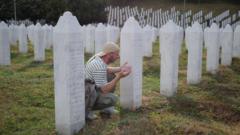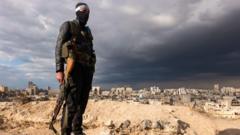Baniyas is a stark reminder of the fragility of peace, with thousands affected by recent violence and a weak government response.
# Struggles Persist as Violence Erupts in Post-War Syria

# Struggles Persist as Violence Erupts in Post-War Syria
Syria faces ongoing conflict and instability as sectarian violence claims lives despite tentative peace.
In early March, the coastal city of Baniyas, once a bustling hub, turned into a scene of horror as violent clashes erupted, revealing the ongoing instability in post-civil war Syria. Emergency crews transformed a looted furniture store into a makeshift morgue, collecting lifeless bodies in body bags as the remnants of violence filled the streets. Scattered debris and burnt vehicles littered the nearly deserted urban landscape. As ambulances streamed in and out, residents desperately sought assistance to recover the remains of their loved ones, highlighting a community paralyzed by fear and grief.
With more than 1,600 civilians, predominantly from the Alawite sect, reported killed over three harrowing days, Baniyas became a grim focal point of sectarian strife fueled by a nebulous security situation. Eyewitness accounts detailed armed groups raiding homes and executing civilians, exposing the vacuity of the new government’s protection for the Alawite minority—a group that once held a privileged position under the Assad regime.
This recent massacre starkly illustrates the ongoing struggle in Syria, as regions remain under tentative control amidst unresolved hostilities. The government’s inability to stabilize Baniyas raises concerns about the safety of its inhabitants and the prevailing risk of wider conflict, even as a semblance of normalcy has been announced in some areas. The unfolding chaos challenges the tenuous progress towards peace after nearly 14 years of civil war, leaving many to question the path ahead for a nation still haunted by division and violence.
With more than 1,600 civilians, predominantly from the Alawite sect, reported killed over three harrowing days, Baniyas became a grim focal point of sectarian strife fueled by a nebulous security situation. Eyewitness accounts detailed armed groups raiding homes and executing civilians, exposing the vacuity of the new government’s protection for the Alawite minority—a group that once held a privileged position under the Assad regime.
This recent massacre starkly illustrates the ongoing struggle in Syria, as regions remain under tentative control amidst unresolved hostilities. The government’s inability to stabilize Baniyas raises concerns about the safety of its inhabitants and the prevailing risk of wider conflict, even as a semblance of normalcy has been announced in some areas. The unfolding chaos challenges the tenuous progress towards peace after nearly 14 years of civil war, leaving many to question the path ahead for a nation still haunted by division and violence.




















